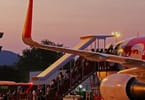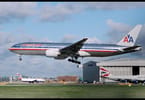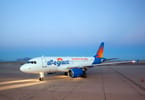London Heathrow Airport CEO John Holland-Kaye speaks at the Airports Commission Public Consultation:
I would like to welcome the panel and the public here today.
The Airports Commission process has encouraged an informed debate on the role of aviation for the national economy, for communities and for the environment.
I thank the Commission for allowing space for the full spectrum of views and evidence to emerge.
Today is another good opportunity for Heathrow to share our expansion plans and to hear the views of our neighbours, the local community and local businesses.
INTRODUCTION
Lack of capacity at Heathrow is restricting Britain’s economic growth, constraining exports, limiting inward investment and jobs.
That is why we are having this discussion once again.
The Airports Commission review is the best and perhaps last opportunity to connect all of Britain to global growth.
This is a debate about the future of our country.
Whether we have the ambition for to win the race for growth, to help Britain stay right at the heart of the global economy, as we have been for centuries”
The Airports Commission has quantified what that means.
It says expansion at Heathrow could generate up to £211billion of economic growth (almost twice the annual NHS budget) and create up to 180,000 new jobs across Britain.
But today, I want to talk about what the prize means for the local communities, businesses and authorities of West London, the Thames Valley and Surrey – our region.
This is a once in a generation opportunity to transform our region through sustainable growth; skilled jobs for local people, career related training, more apprenticeships, better public spaces, improved public transport.
AN APOLOGY
I would like to start by recognizing some of the mistakes of the past.
As I have spoken to local people about our plans for the future, many have pointed to a commitment made by BAA and Heathrow in the past.
I have read the community leaflets distributed by the airport almost 20 years ago which committed to permanently rule out a third runway at Heathrow.
I am shocked by that commitment. It should never have been made. And it could never be kept.
That is not an excuse. It is an apology.
I am sorry Heathrow made that commitment.
It has hung over the relationship with local communities, and has led to a deficit of trust that can only be repaired by demonstrating we are a different company from the past.
Secondly, I would like to turn to the third runway proposal that was promoted in the last decade.
In hindsight, I don’t believe we did enough to listen to the concerns of local communities about that proposal.
We should have done more to reduce noise from aircraft, and ensure those people who stood to lose their homes or suffer more aircraft noise were treated fairly. We should have done more to help local people access the jobs that would come from expansion.
If there was a sense economic benefits should trump environmental costs, or national benefits should hold sway over local disruption, then I am sorry. We got it wrong.
A NEW APPROACH
We have listened and we are responding. Our starting point has been to think about how an expanded Heathrow can fit better into our local community.
How can we deliver the economic growth we need in a sustainable way, and ensure those who are most impacted by expansion get the greatest benefits and are treated fairly.
Heathrow is an integral part of our local community.
Almost one in 4 jobs in local boroughs depend on the airport, the parents of many of the children in local schools work at the airport. Many of the large local employers in our region are here because Heathrow connects them to world markets.
We alone pay around £100m a year in business rates, which contributes to improving local amenities. We have a huge community programme – encouraging science, technology, engineering, and mathematics learning in local schools, lecturing in local universities, helping colleagues to become school governors and investment in community projects.
Our starting point has been to listen to the needs of local people – that is why we are proposing a full length runway which allows respite from noise, the biggest single issue for those who live under the flightpath – something which was not achieved in the previous proposal.
When the Airports Commission shortlisted our proposal last year we held a major public consultation with local residents, businesses and stakeholders.
Over 13,000 people took the chance to have their say on our plans, with over a thousand local residents attending 13 public exhibitions.
The feedback has helped us to address local concerns, for example by preserving historic buildings in Harmondsworth, or seeking a better location for the energy from waste plant.
But it has also showed us how we can deliver more with expansion than we can without; getting rid of routine plane stacking over London, better flood defences, more open space connected together by cycle paths, working with schools and universities to make sure children in local schools today will have the skills to fulfill the 40,000 new jobs needed in an expanded Heathrow – pilots, engineers, IT specialists, customer service roles, security, ground handling, freight handling – the opportunity to create skilled, secure and well-paid careers can transform lives, tackle youth unemployment, fulfill aspirations.
Noise with expansion
Noise is one of the biggest issues.
Although Heathrow is now quieter than it’s been at any time since the 1970s, we know many people are still disturbed by noise.
We have designed our proposal so fewer people will be impacted by noise than today even with expansion – and the Commission has confirmed this.
Our proposed runway is now located farther west to reduce the number of people affected by noise, and the approach is over the M4.
The longer runway allows respite from noise for every community. Flight paths can also be designed to share noise more fairly, allowing 95% of those overflown with respite for at least half of the time.
Aircraft will fly steeper approach paths and touch down farther along the runways so they are higher over local communities, reducing noise.
All these operational measures will be combined with quieter planes and better sound insulation.
The Commission agrees that “When compared to current noise levels, fewer people are predicted to be affected across all metrics”
I know early morning flights are a particular concern for people living close to the airport, many of whom are regularly woken by aircraft today.
Our ability to rotate the runway used for early morning arrivals combined with the capability to land farther down the runway and fly a steeper landing approach means there will be less noise from these flights for communities like Hounslow and Richmond with a three runway Heathrow than with a two-runway Heathrow.
The Commission’s independent analysis has confirmed a third runway would lead to a “positive impact” on night flight noise in the future.
NOISE BLUEPRINT
These are significant improvements on previous proposals. However, since I became CEO in July I have often been asked why we are not doing more now to reduce the impact of noise, such as the point at which planes put down their landing gear, the whistling made by some A320s and compliance with ‘continuous descent approaches’. It is a very fair question. I have asked my team to list all the things we could do as an airport community, find out how we are performing, and put an improvement plan together.
Last week I wrote to the CEOs of 40 airlines who do not comply with all of our quieter operating procedures asking them to take steps to do so.
The noise insulation in schools will be complete by the end of February and cooling for the classrooms that need it the most by the end of summer.
We will also increase the number of schools with ‘adobe’ learning spaces.
Significantly increased noise fines came into effect last month and the proceeds will be invested in local community programs through the Heathrow Community Fund.
Noise Compensation
Sound insulation is also an important part of managing the impacts of noise.
The £250million we have allocated for noise mitigation is a significant improvement – almost 3 times more than was offered under the last proposal for expansion – but in the consultation process some people felt it still did not go far enough
We are therefore developing a further proposal and will make an announcement in the New Year. This will include extending the eligibility for insulation and increased investment in local schools.
There will be fewer schools affected by noise at an expanded Heathrow than there are today.
compensation offer
Although we have reduced the number of homes subject to compulsory purchase, I am acutely aware our proposal still requires the demolition of seven hundred and fifty homes. This is one of the most difficult and emotive topics in this debate.
We need to treat those people who stand to lose their homes fairly. Government guidance suggests a 10% premium to market value is an appropriate payment for home loss. We feel that is insufficient in this case and in May we proposed to pay 25% above unblighted market value, plus legal fees and the stamp duty costs of buying a new home.
This was welcomed during our recent consultation on compensation, but some people living close to the new airport boundary said they wanted the option of moving but were concerned it would be harder to sell their house.
We think this is fair, and so on Monday we announced our intention, if expansion goes ahead, to offer those people who wish to move the same compensation as those whose homes will be compulsorily purchased.
People also want local villages to retain a community feel. Where Heathrow purchases a property from a homeowner we will refurbish and sound insulate the property before reselling it on the open market. This will allow new homeowners to come into the area, and some, whose homes have been lost, to stay in their community.
This offer has to be approved by the Civil Aviation Authority, which oversees all of our investments. But I believe it is the right thing to do and our regulator will agree.
PUBLIC TRANSPORT
With expansion, this area will be at the heart of an integrated transport network, with rail and road links to north, south, east and west – and the Commission has confirmed there will be no material change in the number of cars on roads.
Over 55% of passengers will come to the airport by public transport, compared to just over 40% today. The number of rail seats serving Heathrow will increase threefold; Crossrail will connect to the City and East London; a Piccadilly Line upgrade will offer better frequency and journey times; Western Rail Access for passengers from Slough, Reading and the Thames Valley, as well as the South West and Wales; Southern Rail Access could connect Staines, Twickenham, Richmond, Clapham Junction & Waterloo’. High Speed 2 will connect Heathrow to the Midlands and the North.
We will also have the largest bus and coach station in the UK.
Half of all car journeys to the airport are made by people who work here. Better rail links will reduce this, as will relocating offices and hotels close to the rail station at Terminal 5 and an extended free bus travel zone making it easier for the new and existing local workers to come to Heathrow by bus.
ENVIRONMENT AND AIR QUALITY
Heathrow’s expansion should only go ahead within strict environmental limits on local air quality and within the UK’s climate change targets. We have developed a plan which will deliver this. This includes providing incentives for people to use public transport, reducing staff car parking spaces and if necessary a congestion charge for people travelling to the airport by car.
The Commission’s analysis of road traffic and air quality emissions does not yet account for our mitigation measures, but we are confident once they have, it will confirm air quality limits can be met.
The Cost of Doing Nothing
What happens if Heathrow doesn’t expand? Surely Heathrow could be “better, not bigger”. No. Without expansion Heathrow will be able to do less for our region and for all of Britain. There is a price to not expanding that will be paid in lost jobs and lost opportunities for future generations
The world is changing. All the growth in the world is in Asia and the Americas, markets you can only get to by air from a hub airport like Heathrow. If Britain is going to win the “race for growth” we need to be not only connected to these new markets, but better connected than our European competitors.
But the Airports Commission analysis confirms with a ‘do-nothing’ approach, there will actually be fewer destinations served by Heathrow – we will be worse connected to the growth markets of the world while our competitors in Europe and the Middle East become better connected and take the economic growth that could and should be Britain’s.
Gatwick will not get us there – their solution is for Londoners to fly through Dubai to get to emerging markets. It is not good enough.
For British business people, that means longer journeys and higher costs to get themselves and their exports to global markets.
A less connected London will become less attractive for inward investors, tourists, students. International businesses are less likely to choose London as a base, and those that are here may start to leave.
Businesses that don’t expand tend to employ fewer people. The Commission estimates that within 15 years, Heathrow alone could employ 14,000 fewer people than today if there is no growth at the airport – fewer jobs, fewer apprenticeships, less opportunity for children who are in local schools today.
There is a price for not expanding.
PRIZE TO BE WON
But there is a significant prize from expansion for West London, the Thames Valley, Surrey – and for Britain.
Up to £211 billion of economic growth and up to 180,000 new jobs across the UK.
70,000 jobs in our region.
Heathrow will create jobs while we are building and when we have opened the new airport.
This represents a step change in local employment – in an area with tens of thousands out of work. Unemployment could be cut by 50 per cent and youth unemployment in surrounding boroughs could end.
We will work with schools, colleges and unions to give young people in the area the training and opportunities they need, doubling the number of apprenticeships across the airport to 10,000.
CLOSING
For the last 60 years, our region and Britain have prospered by having the best connected airport in the world on our doorstep. By building on the strength of Heathrow, we can still be the winners in the race for growth, securing the prosperity we have enjoyed for future generations.
Let’s be ambitious and make this happen. Let us work together to deliver the economic growth our region and Britain needs in a sustainable way, and ensure those who are most impacted by expansion get the greatest benefits and are treated fairly.
Thank you
WHAT TO TAKE AWAY FROM THIS ARTICLE:
- Almost one in 4 jobs in local boroughs depend on the airport, the parents of many of the children in local schools work at the airport.
- As I have spoken to local people about our plans for the future, many have pointed to a commitment made by BAA and Heathrow in the past.
- It has hung over the relationship with local communities, and has led to a deficit of trust that can only be repaired by demonstrating we are a different company from the past.






















